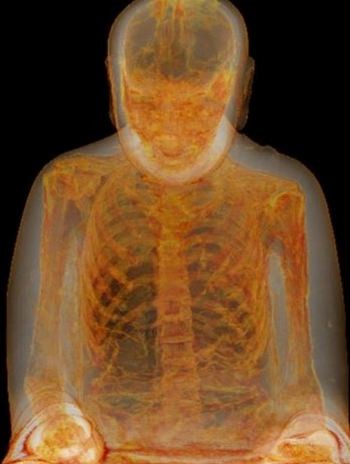A statue of the Buddha nearly 1,000 years-old has yielded the mummified remains of a Chinese monk that happily committed suicide in the hope of reaching Nirvana/
Inside a gold-painted papier-mâché statue found at the Drents Museum in The Netherlands is a body thought to be that of Liuquan, a Buddhist master of the Chinese Meditation School. It's known Liuquan died around the year 1100.
The re-discovery of his mummy also shines a bright light on the gruesome practice of "self-mummification". In this unbearably painful form of suicide, a willing victim intentionally prepared himself for death for as long as six years to attain enlightenment and veneration. The victim refused food and drink and poisoned himself to speed-up his journey to "Buddha-hood".
Liuquan's mummy is so far the only Chinese Buddhist mummy to studied scientifically in the West.
Liuquan was apparently worshiped as a Buddha by his peers as evidenced by paper scraps printed with ancient Chinese characters indicating his high-status as a monk.
The mummy's existence was discovered in 1996 when the statue was being restored in The Netherlands. The find was first reported in December 2014 but only now received widespread media attention, said USA Today.
The Washington Post said researchers knew a human body was inside the statue "that's why it was sent to the Drents Museum in the first place as part of the Mummies exhibition."
DNA tests were conducted on bone samples. Dutch researchers plan to publish its finding in a forthcoming monograph.
Just how horrific the process of Buddhist self-mummification is can be gleaned from a description in the archaeological website, Ancient Origins
"For the first 1,000 days, the monks ceased all food except nuts, seeds, fruits and berries and they engaged in extensive physical activity to strip themselves of all body fat.
"For the next one thousand days, their diet was restricted to just bark and roots. Near the end of this period, they would drink poisonous tea made from the sap of the Urushi tree, which caused vomiting and a rapid loss of body fluids.
"It also acted as a preservative and killed off maggots and bacteria that would cause the body to decay after death.
In the final stage, after more than six years of torturous preparation, the monk would lock himself in a stone tomb barely larger than his body, where he would go into a state of meditation.
"He was seated in the lotus position, a position he would not move from until he died. A small air tube provided oxygen to the tomb.
"Each day, the monk rang a bell to let the outside world know he was still alive. When the bell stopped ringing, the tube was removed and the tomb sealed for the final thousand day period of the ritual.
"At the end of this period, the tomb would be opened to see if the monk was successful in mummifying himself. If the body was found in a preserved state, the monk was raised to the status of Buddha, his body was removed from the tomb and he was placed in a temple where he was worshiped and revered.
"If the body had decomposed, the monk was resealed in his tomb and respected for his endurance, but not worshiped".



























